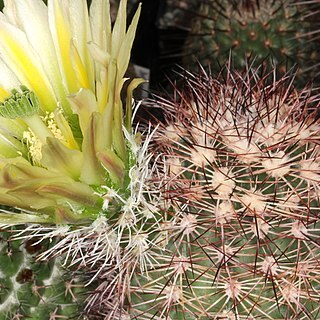Plants unbranched or few branched, forming loose clumps of fewer than 20 stiff branches in old age. Stems erect, ovoid, becoming cylindric with age, 11-23(-40) × (4.5-)5.5-7(-10) cm; ribs (13-)15-19(-21), crests rather sharply undulate; areoles 5-11 mm apart. Spines 19-28 per areole, straight, appressed (radial spines) or spreading in all directions (central spines), presenting relatively bristly appearance (except when spines very short, and then having relatively smooth appearance as in E. pectinatus), pink to pale yellow, white, or tan, less often dark brown or purplish, annual growth increments marked (often vaguely) by rings of spines with contrasting colors; radial spines (16-)17-25(-28) per areole, 5-15(-25) mm; central spines (2-)8-12(-15) per areole, terete, largest spines 4.5-9.5(-14) mm. Flowers 7-8.5(-10) × 7-12 cm; flower tube 10-20 × to 10 mm; flower tube hairs 1-3 mm; inner tepals either yellow (rarely orange-yellow, sometimes becoming salmon-or rose-pink with age), or rose-pink to magenta, proximal 5-30% green in either case, (25-)32-69(-77) × 8-23 mm, tips relatively thin and delicate; anthers yellow; nectar chamber 2-6 mm. Fruits dark dull purplish to maroon (sometimes remaining green), 2-3.5 cm, pulp white to purplish pink. 2n = 44.
More
A cactus. Plants are usually single. The stems are almost round and taper towards the tip. They are 35 cm high and 13 cm across. They are covered with spines. There are 12-21 ribs. The flowers are often on the side of the stems. They are usually yellow but can be pink or purple. They are 5-15 cm across. The fruit are round and 3-4 cm across. They are green to greenish-purple. The spines on them fall off.
Xerophyllous scrub, grasslands, and on rocks., growing in sandy valleys to stony hills in limestone; at elevations from 1,200-1,500 metres.


